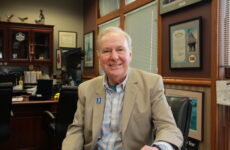An hour before the Native Pride Dancers performance starts, Larry Yazzie and Arlan Whitebreast sit backstage preparing themselves. Whitebreast begins to put on his traditional garb as Yazzie puts together his bustles, which is a colorful spread of feathers and beads.
“(Dancing) was a calling for me,” Yazzie said. “ Before this, I tried the regular workforce. I worked a regular 9-5 job, but I have a deep love for the dance.”
The performance starts with Larry introducing Wendall Powless, who provides the voice and the drumbeat throughout much of the performance.
Both of which, Yazzie believes, propels the dancers.
“The drum is the heartbeat of our people,” Yazzie said to the audience. “ Without the drum, we wouldn’t be able to do a lot of our dances.”
Later, Whitebreast comes out to perform the Grass dance, repeatedly stamping his feet on the ground. He explains this is to flatten the tall prairie grass in preparation for a ceremony.
Despite the seriousness of which all of the Native Pride Dancers take their dances, humor is very much apart of the performance, disarming stereotypes.
At one point Powless teases Yazzie on stage, encouraging people to ask him if “his braids are real.”
Before, during and after the performance, Yazzie stresses that fighting stereotypes is one of the big reasons they travel around the world and the United States, from Japan to France to the Middle East.
“Dancing is a way of life for me. At the same time it’s also a way to break the stereotypes that we encounter as Native American people,” Yazzie said.
Breaking these stereotypes is also what led the DMACC Diversity Commission to bring the Native Pride Dancers to the Ankeny campus.
The performance was co-sponsored by the DMACC Diversity Commission and the DMACC Ankeny Campus Student Activities Council. Jennifer Keahna, an at-large member of the Commission was responsible for organizing the event.
Kenahna is a member of the Meskwaki tribe, so the performance is especially important to her. She believes that a lot of people have misconceptions about Native Americans and view them as only historical figures. Her daughter, who is a student in the Ankeny schools, found that none of her friends believed she was Native American as they thought they were all extinct.
“(I want) to open some people’s eyes; Native Americans are not just characters from the past … the culture is still flourishing.”
Tawny Hale, Dana Davenport, and Sade Kapayou demonstrate this as they perform the Women’s Fancy Shawl dance. Backstage, before the performance, Hale explained that the dance is more contemporary.
“It incorporates more footwork than the traditional styles of Northern and Southern women dance,” Hale said.
The performance is closed out with a question and answer with the audience, but not before the Native Pride Dancers ask for audience members to participate. The dancers show the volunteers some basic dance moves. To get the audience comfortable, they start with the Black Eyed Peas song “I’ve Gotta Feeling” for brief amount of time, then nearly seamlessly transitioning into traditional pow-wow song, as if to show just how closely related drum is in all music and dance, not just Native American.
The performance drew not just DMACC students, but some Iowa State students as well.
Edee Wildman, freshman at Iowa State, who took part in the audience participation portion, was glad she came.
“It was great to see the passion and to see the families performing together,” Wildman said.
This is exactly what Yazzie expressed as he was preparing for the performance.
“That is our mission: To inspire, to educate, and to motivate through music and dance.”





Comments